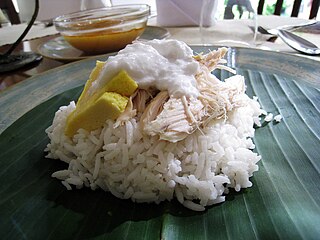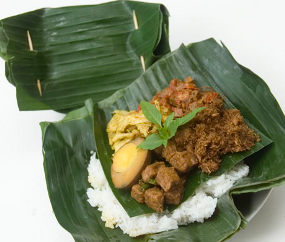
A fried egg is a cooked dish made from one or more eggs which are removed from their shells and placed into a frying pan and fried. They are traditionally eaten for breakfast in many countries but may also be served at other times of the day.

Malaysian cuisine consists of cooking traditions and practices found in Malaysia, and reflects the multi-ethnic makeup of its population. The vast majority of Malaysia's population can roughly be divided among three major ethnic groups: Malays, Chinese and Indians. The remainder consists of the indigenous peoples of Sabah and Sarawak in East Malaysia, the Orang Asli of Peninsular Malaysia, the Peranakan and Eurasian creole communities, as well as a significant number of foreign workers and expatriates.

Indonesian cuisine is a collection of various regional culinary traditions that formed in the archipelagic nation of Indonesia. There are a wide variety of recipes and cuisines in part because Indonesia is composed of approximately 6,000 populated islands of the total 17,508 in the world's largest archipelago, with more than 1,300 ethnic groups.

Malay cuisine is the traditional food of the ethnic Malays of Southeast Asia, residing in modern-day Malaysia, Indonesia, Singapore, Brunei, Southern Thailand and the Philippines as well as Cocos Islands, Christmas Island, Sri Lanka and South Africa.

Fried rice is a dish of cooked rice that has been stir-fried in a wok or a frying pan and is usually mixed with other ingredients such as eggs, vegetables, seafood, or meat. It is often eaten by itself or as an accompaniment to another dish. Fried rice is a popular component of East Asian, Southeast Asian and certain South Asian cuisines, as well as a staple national dish of Indonesia. As a homemade dish, fried rice is typically made with ingredients left over from other dishes, leading to countless variations. Fried rice first developed during the Sui Dynasty in China.

Chinese Indonesian cuisine is characterized by the mixture of Chinese with local Indonesian style. Chinese Indonesians, mostly descendant of Han ethnic Hokkien and Hakka speakers, brought their legacy of Chinese cuisine, and modified some of the dishes with the addition of Indonesian ingredients, such as kecap manis, palm sugar, peanut sauce, chili, santan and local spices to form a hybrid Chinese-Indonesian cuisine. Some of the dishes and cakes share the same style as in Malaysia and Singapore, known as Nyonya cuisine by the Peranakan.

Nasi goreng is a Southeast Asian fried rice dish, usually cooked with pieces of meat and vegetables. One of Indonesia's national dishes, it is also eaten in Malay-speaking communities in countries such as Malaysia, Singapore and Brunei, and has gained popularity in Sri Lanka through migrations from the Indonesian Archipelago, in countries like Suriname via Indonesian immigrant communities, and in the Netherlands through its colonial ties with Indonesia. Nasi goreng is distinguished from other Asian fried rice preparations by its distinct smoky aroma, and caramelised yet savoury undertones of flavour. There is no single defined recipe for nasi goreng, and its composition and preparation varies greatly from household to household.

Chicken feet are cooked and eaten in many countries. After an outer layer of hard skin is removed, most of the edible tissue on the feet consists of skin and tendons, with no muscle. This gives the feet a distinct gelatinous texture different from the rest of the chicken meat.

Lontong is an Indonesian dish made of compressed rice cake in the form of a cylinder wrapped inside a banana leaf, commonly found in Indonesia, Malaysia, and Singapore. Rice is rolled inside a banana leaf and boiled, then cut into small cakes as a staple food replacement for steamed rice. The texture is similar to that of ketupat, with the difference being that the ketupat container is made from woven janur fronds, while lontong uses banana leaf instead.

Javanese cuisine is the cuisine of Javanese people, a major ethnic group in Indonesia, more precisely the province of Central Java, Yogyakarta and East Java.

Nasi liwet is an Indonesian dish rice dish cooked in coconut milk, added with chicken broth, salam leaves, lemongrass, and spices, from Solo, Central Java, Indonesia. Thus, the rice has a rich, aromatic, and succulent taste. The uniqueness of nasi liwet is that it applies a traditional Javanese way of cooking rice in coconut milk. There is another popular variant of the dish, which is the style of Nasi Liwet Sunda from West Java. It is a unique Sundanese cuisine with different taste and presentation, from the Sundanese eating tradition called ngeliwet or botram.

Nasi bogana or nasi begana, pronounced as nah-see boh-gâna, is an Indonesian-style rice dish, originally from Tegal, Central Java. It is usually wrapped in banana leaves and served with side dishes.

Semur is an Indonesian meat stew braised in thick brown gravy. It is commonly found in Indonesian cuisine. The main ingredients in the gravy are sweet soy sauce, shallots, onions, garlic, ginger, candlenut, nutmeg, and cloves.

Lontong cap go meh is a Chinese Indonesian take on traditional Indonesian dishes, more precisely Javanese cuisine. It is lontong served with richly-flavoured dishes which include opor ayam chicken in coconut milk, sayur lodeh vegetable soup, hot and spicy liver, hard-boiled pindang egg, koya powder made of soy and dried shrimp or beef floss, pickles, chili paste and prawn cracker. Lontong cap go meh is usually consumed by the Chinese Indonesian community during the Cap go meh celebration.

Telur pindang or pindang eggs are hard-boiled eggs cooked in the pindang process, originating from Javanese cuisine, Indonesia, and popular in Malay as well as Palembang cuisine. The eggs are boiled slowly in water mixed with salt, soy sauce, shallot skins, teak leaf, and other spices. Due to its origins, it bears striking similarities with Chinese tea eggs. However, instead of black tea, this version uses leftover shallot skins, teak leaves or guava leaves as dark brownish coloring agents.

Betawi cuisine is rich, diverse and eclectic, in part because the Betawi people that create them were composed from numbers of regional immigrants that came from various places in the Indonesian archipelago, as well as Chinese, Indian, Arab, and European traders, visitors and immigrants that were attracted to the port city of Batavia since centuries ago.

Pindang refers to a cooking method in the Indonesian and Malay language of boiling ingredients in brine or acidic solutions. Usually employed to cook fish or egg, the technique is native to Sumatra especially in Palembang, but has spread to Java and Kalimantan. The term also could refer to a specific sour and spicy fish soup which employs seasonings like tamarind. Pindang has food preservation properties, which extends the shelf life of fish products.

Palembangese cuisine is the cuisine of the Palembangese people of the city of Palembang in the South Sumatra province of Indonesia. It is the second most well-known cuisine from Sumatra after Padang.

Indian Indonesian cuisine is characterized by the mixture of Indian cuisine with local Indonesian-style. This cuisine consists of adaptations of authentic dishes from India, as well as original creations inspired by the diverse food culture of Indonesia. Indian influence can be observed in Indonesia as early as the 4th century. Following the spread of Islam to Indonesia and trading, Muslim Indian as well as Arab influences made their way into Indonesian cuisine. Examples include Indian biryani, murtabak, curry and paratha that influenced Acehnese, Minangkabau, Malay, Palembangese, Betawi and Javanese cuisine.

Indo cuisine is a fusion cooking and cuisine tradition, mainly existing in Indonesia and the Netherlands, as well as Belgium, South Africa and Suriname. This cuisine characterized of fusion cuisine that consists of original Indonesian cuisine with Eurasian-influences—mainly Dutch, also Portuguese, Spanish, French and British—and vice versa. Nowaday, not only Indo people consume Indo cuisine, but also Indonesians and Dutch people.























